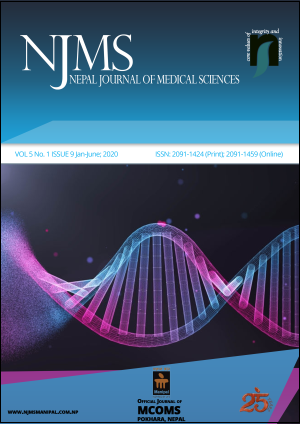The Role of Magnetic Resonance Imaging in Traumatic Knee Injury
DOI:
https://doi.org/10.3126/njms.v5i1.36952Keywords:
Injury, knee, Magnetic Resonance ImagingAbstract
Introduction: Magnetic Resonance Imaging (MRI) as a non-invasive modality plays a vital role in assessment of a wide spectrum of internal knee derangements. This study focuses on the commonest anatomical derangement and reveals the importance of MRI to characterize the pattern of derangement in the assessment of the patient with knee injury.
Methods: This is the hospital based prospective study conducted among 65 patients referred to department of radiology with first presentation of knee injury during two years period from August, 2013 to August, 2015. Patient fulfilling the inclusion criteria underwent Magnetic Resonance Imaging knee in SIEMENS MAGNETOM C 0.35 Tesla MRI machine, after taking written informed consent. Descriptive analysis of data was analyzed using SPSS 20.0 program
Result: Of the total 65 patients with knee injury, Sport injuries were the most common mode of knee injury. 63 cases with trauma had findings on MRI. Most of the cases presented with joint effusion (59 cases). Anterior Cruciate Ligament (ACL) tear is the commonest injury (37 cases) during knee trauma followed by Medial Collateral Ligament (MCL), Medial Meniscus, Posterior Cruciate Ligament (PCL), Lateral Meniscus and Lateral Collateral Ligament(LCL) injuries.
Conclusion: MRI as a high-contrast soft-tissue imaging technique can be used as a noninvasive modality to assess a wide spectrum of internal knee derangements in a patient with knee injury. Specific pattern of bone bruise can guide us to narrow our diagnosis.
Downloads
Downloads
Published
How to Cite
Issue
Section
License
Copyright © by Nepal Journal of Medical Sciences. The ideas and opinions expressed by authors of articles summarized, quoted, or published in full text in this Journal represents only opinions of authors and do not necessarily reflect the official policy of Nepal Journal of Medical Sciences or the institute with which the author(s) is (are) affiliated, unless so specified.




